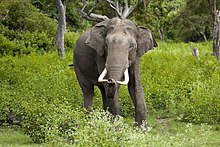
Back ভারতের প্রাণী Bengali/Bangla އިންޑިޔާގެ ސޫފާސޫފި DV החי בהודו HE भारत के जीव-जंतु Hindi Biodiversità in India Italian ഇന്ത്യയിലെ ജന്തുജാലം Malayalam ਭਾਰਤ ਦੇ ਜੀਵ ਜੰਤੂ Punjabi Фауна Индии Russian Hindistan faunası Turkish Фауна Індії Ukrainian


| Wildlife of India |
|---|
 |
India is the world's 8th most biodiverse region with a 0.46 BioD score on diversity index, 102,718 species of fauna and 23.39% of the nation's geographical area under forest and tree cover in 2020.[1] India encompasses a wide range of biomes: desert, high mountains, highlands, tropical and temperate forests, swamplands, plains, grasslands, areas surrounding rivers, as well as island archipelago. Officially, three out of the 36 Biodiversity Hotspots in the world are present in India: the Himalayas, the Western Ghats, and the Indo-Burma region. To these may be added the Sundarbans and the Terrai-Duar Savannah grasslands for their unique foliage and animal species.[2] These hotspots have numerous endemic species.[3] Nearly 5% of India's total area is formally classified under protected areas .
India, for the most part, lies within the Indomalayan realm, with the upper reaches of the Himalayas forming part of the Palearctic realm; the contours of 2000 to 2500m are considered to be the altitudinal boundary between the Indo-Malayan and Palearctic zones. India displays significant biodiversity. One of seventeen megadiverse countries, it is home to 7.6% of all mammalian, 12.6% of all avian, 6.2% of all reptilian, 4.4% of all amphibian and 11.7% of all fish.
The region is also heavily influenced by summer monsoons that cause major seasonal changes in vegetation and habitat. India forms a large part of the Indomalayan biogeographical zone and many of the floral and faunal forms show Malayan affinities with only a few taxa being unique to the Indian region. The unique forms includes the snake family Uropeltidae found only in the Western Ghats and Sri Lanka. Fossil taxa from the Cretaceous show links to the Seychelles and Madagascar chain of islands.[4] The Cretaceous fauna include reptiles, amphibians and fishes and an extant species demonstrating this phylogeographical link is the purple frog. The separation of India and Madagascar is traditionally estimated to have taken place about 88 million years ago. However, there are suggestions that the links to Madagascar and Africa were present even at the time when the Indian subcontinent met Eurasia. India has been suggested as a ship for the movement of several African taxa into Asia. These taxa include five frog families (including the Myobatrachidae), three caecilian families, a lacertid lizard and freshwater snails of the family Pomatiopsidae.[5] A thirty million year old Oligocene-era fossil tooth from the Bugti Hills of central Pakistan has been identified as from a lemur-like primate, prompting controversial suggestions that the lemurs may have originated in Asia.[6][7] Lemur fossils from India in the past led to theories of a lost continent called Lemuria. This theory however was dismissed when continental drift and plate tectonics became well established.
India is home to several well-known large mammals, including the Asian elephant, Bengal tiger, Asiatic lion, Indian leopard and Indian rhinoceros. Some of these animals are engrained in Indian culture, often being associated with deities. These large mammals are important for wildlife tourism in India, with several national parks and wildlife sanctuaries catering to these needs. The popularity of these charismatic animals have greatly helped conservation efforts in India. The tiger has been particularly important, and Project Tiger, started in 1972, was a major effort to conserve the tiger and its habitats.[8] Project Elephant, though less known, started in 1992 and works for elephant protection.[9] Most of India's rhinos today survive in the Kaziranga National Park.
Some other well-known large Indian mammals are ungulates such as the water buffalo, nilgai, gaur and several species of deer and antelope. Some members of the dog family such as the Indian wolf, Bengal fox, golden jackal and the dhole or wild dogs are also widely distributed. It is also home to the striped hyena. Many smaller animals such as macaques, langurs and mongoose species are especially well known due to their ability to live close to or inside urban areas.
The majority of conservation research attention on wildlife in India is focused within protected areas, though there is considerable wild fauna outside such reserves including in farmlands and in cities.[10][11][12]
- ^ Cite error: The named reference
bod1was invoked but never defined (see the help page). - ^ Bagli, Katie (31 May 2021). "Here's a look at 6 biodiversity hotspots of India". The Hindu.
- ^ [1] Archived 9 November 2005 at the Wayback Machine
- ^ Jean-Claude Rage (2003) Relationships of the Malagasy fauna during the Late Cretaceous: Northern or Southern routes? Acta Palaeontologica Polonica 48(4):661-662 PDF Archived 14 December 2004 at the Wayback Machine
- ^ Briggs, JC (2003) The biogeographic and tectonic history of India. Journal of Biogeography, 30:381–388
- ^ Marivaux L., Welcome J.-L., Antoine P-O., Métais G., Baloch I.M., Benammi M., Chaimanee Y., Ducrocq S., and Jaeger J.-J. (2001) A fossil lemur from the Oligocene of Pakistan. Science, 294: 587–591.
- ^ Oligocene Lemur fossil hints at Asian origin Archived 6 October 2017 at the Wayback Machine. Retrieved February 2007.
- ^ Project Tiger Archived 11 February 2016 at the Wayback Machine Accessed Feb, 2007
- ^ Project Elephant Archived 19 January 2007 at the Wayback Machine Accessed Feb, 2007
- ^ Prajapathi, Utkarsh; Koli, Vijay K.; Sundar, K. S. Gopi (2021). "Vulnerable sloth bears are attracted to human food waste: a novel situation in Mount Abu town, India". Oryx. 55 (5): 699–707. doi:10.1017/S0030605320000216.
- ^ Choudaj, Kiran; Wankhade, Varsha (2023). "Study of the interrelationship between woody plants and birds in Pune urban area, insights on negative impacts of exotic plants". Tropical Ecology. 64 (2): 264–275. Bibcode:2023TrEco..64..264C. doi:10.1007/s42965-022-00269-3. S2CID 252193648.
- ^ Dhindsa, Manjit S.; Saini, Harjeet K. (1994). "Agricultural ornithology: an Indian perspective". Journal of Biosciences. 19 (4): 391–402. doi:10.1007/BF02703176. S2CID 19183508.